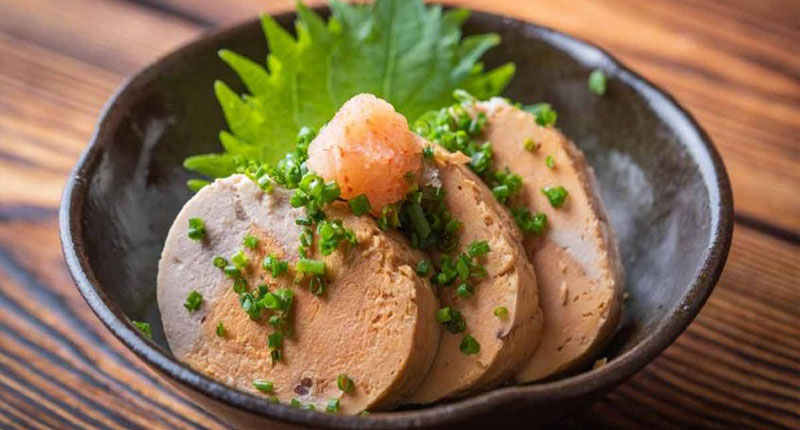Are you a fan of Japanese cuisine? If you enjoy exploring new flavors and unique dishes, then you're in for a treat. In this article, we will delve into the world of delicious Ankimo, a Japanese delicacy that has been captivating food enthusiasts around the globe. From its origins to the step-by-step recipe, we'll cover everything you need to know to savor this delightful dish. So, let's dive in!
When it comes to Japanese cuisine, Ankimo holds a special place. Often referred to as "foie gras of the sea," it is a delicacy made from the liver of a monkfish, known as Ankimo in Japanese. The dish has a rich, creamy texture and a distinct umami flavor that leaves a lasting impression on your taste buds.
The Origins of Ankimo
Ankimo has its roots deeply embedded in Japanese culinary traditions. It is believed to have originated in the Kansai region of Japan, where it was initially created as a way to make use of the monkfish liver, which was often discarded. Over time, this humble ingredient gained popularity and transformed into a highly sought-after delicacy.
The Uniqueness of Ankimo
What sets Ankimo apart is its unique production process. The monkfish liver is carefully cleaned and deveined, then seasoned with salt and washed with sake. It is then steamed until perfectly cooked, resulting in a silky, melt-in-your-mouth texture. The final product is often sliced and served cold, accompanied by traditional condiments like grated daikon radish, ponzu sauce, and green onions.
Ingredients Required
To prepare Ankimo, you will need the following ingredients:
- Fresh monkfish liver
- Salt
- Sake
- Grated daikon radish
- Ponzu sauce
- Green onions
Step-by-Step Recipe Guide
Now let's dive into the step-by-step process of making delicious Ankimo:
- Begin by cleaning the monkfish liver thoroughly, removing any impurities and veins.
- Season the liver generously with salt, ensuring it is evenly coated.
- Rinse the liver with sake to remove any fishy odor and impart a delicate flavor.
- Prepare a steamer and place the seasoned liver inside. Steam for about 30-40 minutes until cooked through.
- Once the liver is cooked, remove it from the steamer and let it cool to room temperature.
- Wrap the liver tightly in plastic wrap and refrigerate for at least 24 hours. This process helps enhance the flavor and texture.
- After refrigeration, unwrap the liver and slice it into thin pieces.
- Serve the Ankimo slices chilled, garnishing with grated daikon radish, ponzu sauce, and finely chopped green onions.
- Enjoy the exquisite flavors of this Japanese delicacy!
Variations and Serving Suggestions
While Ankimo is traditionally served as chilled slices, you can also explore different serving variations. Some popular options include:
- Grilling: Lightly grilling the Ankimo slices adds a smoky flavor and a crispy texture.
- Sushi Roll: Incorporating Ankimo into a sushi roll creates a delightful combination of flavors.
- Ankimo Pate: Blending the Ankimo with other ingredients creates a creamy pate that can be enjoyed as a spread on crackers or bread.
Health Benefits of Ankimo
Apart from its delightful taste, Ankimo also offers several health benefits. It is a good source of omega-3 fatty acids, which are known to promote heart health and reduce inflammation. Additionally, Ankimo is rich in vitamins and minerals, making it a nutritious addition to your diet.
Tips and Tricks for Perfect Ankimo
Here are a few tips to ensure your Ankimo turns out perfectly:
- Select fresh monkfish liver for the best taste and texture.
- Properly clean and devein the liver to remove any unwanted flavors.
- Allow the Ankimo to chill for at least 24 hours to enhance its flavor.
- Experiment with different serving variations to find your preferred way of enjoying Ankimo.
Conclusion
Ankimo is truly a Japanese delicacy that showcases the artistry and sophistication of their culinary traditions. Its rich flavor, velvety texture, and unique production process make it an unforgettable experience for any food enthusiast. Whether you savor it as a standalone dish or explore creative serving variations, Ankimo is sure to leave a lasting impression on your taste buds.
Frequently Asked Questions (FAQs)
1. Can I substitute monkfish liver with any other type of liver?
- While monkfish liver is the traditional choice for Ankimo, you can experiment with other types of fish liver, such as cod or halibut.
2. Where can I find monkfish liver?
- Monkfish liver can be found in well-stocked seafood markets, specialty Japanese grocery stores, or online seafood suppliers.
3. Is Ankimo safe to eat?
- Yes, Ankimo is safe to eat when prepared and handled properly.
4. How long can I store Ankimo?
- Ankimo can be refrigerated for up to three days, but it is best enjoyed fresh.
5. Are there any vegetarian alternatives to Ankimo?
- Yes, some vegetarian alternatives aim to replicate the flavors and texture of Ankimo using plant-based ingredients.














